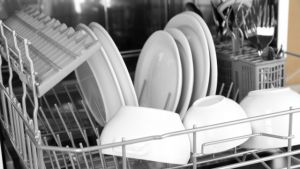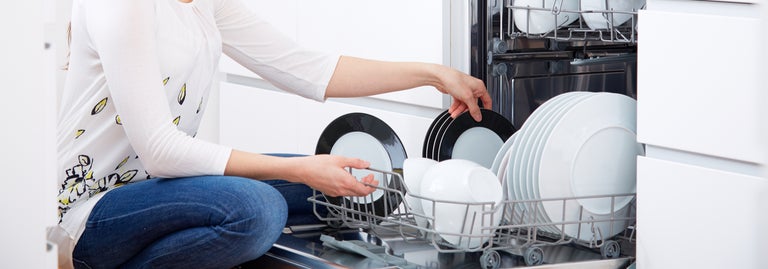It’s something you likely do on the daily: load up your dishwasher with dirty cups and plates until it’s full enough to run. But ever wondered why some plates come out dirty or your wooden spoons have cracked? Have you questioned what way you should really be stacking your plates? Canstar has got the low-down on loading your dishwasher the right way.
1. Location, location
Make sure you’re loading from back to front to fit in maximum dishes. Thin plastics like takeaway containers should be stacked on the top rack to prevent them from melting. Put bowls and cups facedown or on an angle so they don’t collect puddles of water, and keep plates on the bottom shelf, where the spray is strongest. Avoid over-cluttering, if the water can’t reach something, it won’t get cleaned.
2. Cups and glasses placement
It’s a common mistake we’re likely all making: glassware does belong on the top rack, but cups and glasses shouldn’t be placed on top of the tines (the pointy sticks dishes sit between on the rack of the dishwasher). They should actually be placed in between the tines to prevent the cracks that can happen when they bump against each other during the cycle.
3. Plate direction
Avoid loading your dirty plates in a single direction. You should arrange them all facing the center so they have even access to the soap and sprayer. Alternate between large and small sizes when you’re loading, too, to give them the best water flow.

4. Avoid over-rinsing
Rinsing your dishes before loading them into the dishwasher is actually wasting water and your energy. Dishwasher detergents are designed to cling to food particles and separate them from their surfaces, so just scrape off large food scraps into the bin and leave the rest.
5. Use the correct wash program for your dishes
Most dishwashers offer a range of programs, with different power consumption and water-usage levels. Even though an eco-wash might take longer, overall it could use less than half the electricity of a normal wash. For a modern Bosch machine with a 4-star energy rating, the difference between a quick 60-min wash and an eco-wash equates to a saving of approx $55 of power per year (based on one load per day).
For even bigger savings on your power usage, check out Canstar’s review of power deals:
- For more information on providers, check out our links below.Canstar Blue’s 2019 review of NZ power companies compares Powershop, Electric Kiwi, Flick Electric Co., Energy Online, Nova Energy, Pulse Energy, Meridian Energy, Mercury Energy, Genesis Energy, Contact Energy, GLOBUG and Trustpower on customer satisfaction. The table below is an abridged version of our full results, available here.
See Our Ratings MethodologyShow Important Notes^** Overall satisfaction is an individual rating and not a combined total of all ratings. By default, brands with equal overall satisfaction ratings are sorted by the mean overall satisfaction score as rated by consumers. You can click the arrows at the top of any column in the table to sort by the results in that column.
^ By clicking on a brand or 'details' button, you will leave Canstar Blue and be taken to either a product provider website or a Canstar Blue NZ brand page. You agree that Canstar Blue NZ’s terms and conditions apply (without limitation) to your use of this service,to any referral to a product provider from our website, and any transaction that follows. Canstar Blue may earn a fee for referrals from its website tables, and from sponsorship (advertising) of certain products. Payment of sponsorship fees does not influence the star rating that Canstar Blue awards to a sponsored product. Fees payable by product providers for referrals and sponsorship may vary between providers, website position, and revenue model. Sponsorship fees may be higher than referral fees. Sponsored products are clearly disclosed as such on website pages. They may appear in a number of areas of the website such as in comparison tables, on hub pages and in articles. Sponsored products may be displayed in a fixed position in a table, regardless of the product’s rating, price or other attributes. The table position of a sponsored product does not indicate any ranking, rating or endorsement by Canstar Blue. See How we are funded for further details.
Canstar Blue NZ Research finalised in April 2023, published in June 2023.
6. Leave your biggest knives and wooden spoons out
Avoid putting sharp knives and wooden spoons in the dishwasher. The heat of the water can degrade these items, and faster than you think. Things like big plastic serving spoons and spatulas should lie flat in the top rack of the dishwasher. Loading them in the utensil basket likely will just block the spray from reaching your other utensils.
7. Vary your knife and fork placement in the basket
Ever lived with someone pedantic about the perfect and upright placement of cutlery in the dishwasher? Turns out it’s not actually worth it. It’s better to alternate their directions, with some handles facing up and others down, to keep them from falling into each other. They will get a more even clean this way.
8. Don’t overload
Don’t overload your dishwasher, your dishes won’t come out as clean as you’d hope, and you’ll end up wasting water and running another cycle. Just hand wash a couple of things and save yourself the trouble.
9. Bulky items beware
Large things such as cutting boards and casserole dishes should go at the back or sides of your bottom rack. If bulky items at placed at the front, it’s possible they’ll block the soap dispenser and prevent detergent from reaching the rest of the dishes.

10. Other things to keep out
Avoid putting in cast iron, copper and non-stick pans. These all need a little more love and care, so hand wash them. Anything with adhesive labels also isn’t the best for a dishwasher. Labels with glue can clog and hurt it. It’s best to either get rid of the labels before putting the item in the dishwasher, or simply wash the item by hand.
Compare electricity providers for free with Canstar!
Enjoy reading this article?
You can like us on Facebook and get social, or sign up to receive more news like this straight to your inbox.
By subscribing you agree to the Canstar Privacy Policy


Share this article